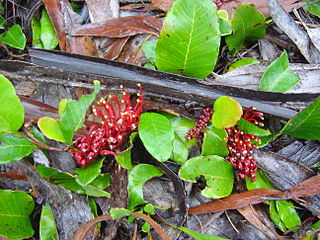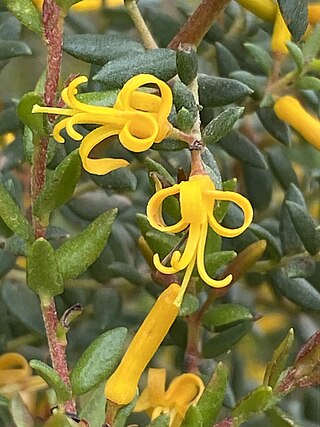
Persoonia, commonly known as geebungs or snottygobbles, is a genus of about one hundred species of flowering plants in the family Proteaceae. Plants in the genus Persoonia are shrubs or small trees usually with smooth bark, simple leaves and usually yellow flowers arranged along a raceme, each flower with a leaf or scale leaf at the base. The fruit is a drupe.

Grevillea laurifolia, commonly known as laurel-leaf grevillea, is a species of flowering plant in the family Proteaceae. It is endemic to New South Wales, Australia. It is a prostrate, trailing shrub with egg-shaped, heart-shaped or round leaves, and clusters of reddish to deep maroon flowers.

Persoonia nutans, commonly known as the nodding geebung, is a plant in the family Proteaceae and is endemic to part of the Sydney region in New South Wales. It is an erect to spreading shrub with linear leaves and yellow flowers on down-turned pedicels.

Persoonia levis, commonly known as the broad-leaved geebung, is a shrub native to New South Wales and Victoria in eastern Australia. It reaches 5 m (16 ft) in height and has dark grey papery bark and bright green asymmetrical sickle-shaped leaves up to 14 cm (5.5 in) long and 8 cm (3.2 in) wide. The small yellow flowers appear in summer and autumn, followed by small green fleshy fruit, which are classified as drupes. Within the genus Persoonia, it is a member of the Lanceolata group of 58 closely related species. P. levis interbreeds with several other species where they grow together.

Persoonia linearis, commonly known as the narrow-leaved geebung, is a shrub native to New South Wales and Victoria in eastern Australia. It reaches 3 m (9.8 ft), or occasionally 5 m (16 ft), in height and has thick, dark grey papery bark. The leaves are, as the species name suggests, more or less linear in shape, and are up to 9 cm (3.5 in) long, and 0.1 to 0.7 cm wide. The small yellow flowers appear in summer, autumn and early winter, followed by small green fleshy fruit known as drupes. Within the genus Persoonia, it is a member of the Lanceolata group of 58 closely related species. P. linearis interbreeds with several other species where they grow together.

Persoonia lanceolata, commonly known as lance-leaf geebung, is a shrub native to New South Wales in eastern Australia. It reaches 3 m (10 ft) in height and has smooth grey bark and bright green foliage. Its small yellow flowers grow on racemes and appear in the austral summer and autumn, followed by green fleshy fruits which ripen the following spring. Within the genus Persoonia, P. lanceolata belongs to the lanceolata group of 58 closely related species. It interbreeds with several other species found in its range.

Persoonia juniperina, commonly known as prickly geebung, is a species of flowering plant in the family Proteaceae and is endemic to south-eastern Australia. It is a small erect to low-lying shrub with smooth bark, hairy new branches, linear leaves, yellow flowers borne singly or in groups of up to forty in leaf axils, and yellowish green to purplish fruit.

Persoonia laurina, commonly known as the laurel-leaved or laurel geebung, is a shrub of the family Proteaceae native to central New South Wales in eastern Australia. Found in sclerophyll forest, it grows to a height of 2 metres. The yellow flowers appear in late spring.

Persoonia chamaepitys, commonly known as the prostrate- or mountain geebung, is a shrub endemic to New South Wales in eastern Australia. It has a prostrate habit, reaching only 20 cm (7.9 in) high but spreading up to 2 m (6.6 ft) across, with bright green spine-like leaves and small yellow flowers appearing in summer and autumn.

Persoonia oxycoccoides is a species of flowering plant in the family Proteaceae and is endemic to New South Wales, Australia. It is a spreading to prostrate shrub with smooth bark, hairy young branchlets, elliptic to egg-shaped leaves and yellow flowers arranged in groups of up to thirteen along a rachis that continues to grow after flowering.

Persoonia myrtilloides, commonly known as myrtle geebung, is a plant in the family Proteaceae and is endemic to New South Wales. It is an erect to spreading shrub with elliptic to egg-shaped leaves and yellow flowers in groups of up to forty on a rachis up to 170 mm (6.7 in) long.

Persoonia glaucescens, commonly known as the Mittagong geebung, is a species of flowering plant in the family Proteaceae and is endemic to New South Wales. It is an erect shrub with smooth bark, hairy young branchlets, lance-shaped leaves with the narrower end towards the base, and yellow flowers. It is the only persoonia in eastern Australia with strongly glaucous leaves.

Persoonia hirsuta, commonly known as the hairy geebung or hairy persoonia, is a species of flowering plant in the family Proteaceae. It is endemic to eastern New South Wales, Australia. It is a hairy, spreading to low-lying shrub with linear, lance-shaped or spatula-shaped leaves and yellow or orange flowers arranged singly or in groups of up to ten on a rachis up to 20 mm (0.79 in) long.

Persoonia mollis, commonly known as soft geebung, is a plant in the family Proteaceae and is endemic to New South Wales. It is an erect to prostrate shrub with linear to oblong or spatula-shaped leaves, yellow flowers in groups of up to thirty on a rachis up to 150 mm (5.9 in) long and relatively small fruit.

Persoonia prostrata is a plant in the family Proteaceae and is endemic to the northern tip of K'gari in Queensland, but is presumed to be extinct. It is similar to Persoonia stradbrokensis but is a prostrate shrub with smaller leaves and flowers.

Persoonia bargoensis, commonly known as the Bargo geebung, is a species of flowering plant in the family Proteaceae and is endemic to a restricted area of New South Wales. It is an erect shrub with linear to lance-shaped leaves, yellow, tube-shaped flowers and green, pear-shaped fruit.

Persoonia falcata, commonly known as the wild pear, is a shrub native to northern Australia.

Persoonia media is a species of flowering plant in the family Proteaceae and is endemic to eastern Australia. It is an erect to spreading shrub or tree with branchlets and leaves that are glabrous or only sparsely hairy, elliptic to egg-shaped and up to sixteen yellow flowers on a rachis up to 150 mm (5.9 in) long.

Persoonia asperula, commonly known as mountain geebung, is a plant in the family Proteaceae and is endemic to south-eastern Australia. It is an erect or prostrate shrub with smooth bark, mostly elliptic to oblong leaves and yellow flowers borne singly or in groups of up to nine. It mostly occurs in the Southern Highlands of New South Wales. A small population in Victoria may be a different species.

Persoonia tenuifolia, commonly known as fine-leaf geebung is a plant in the family Proteaceae and is endemic to eastern Australia. It is an erect to low-lying shrub with hairy young branchlets, linear leaves, and yellow flowers in groups of up to eight on a rachis 2–30 mm (0.079–1.181 in) long that continues to grow after flowering.























